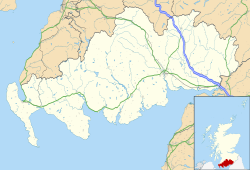| Arkleton | |
|---|---|
Location within Dumfries and Galloway | |
| OS grid reference | NY3791 |
| Council area | |
| Lieutenancy area | |
| Country | Scotland |
| Sovereign state | United Kingdom |
| Post town | LANGHOLM |
| Postcode district | DG13 |
| Dialling code | 013873 |
| Police | Scotland |
| Fire | Scottish |
| Ambulance | Scottish |
| UK Parliament | |
| Scottish Parliament | |

Arkleton is a mansion and estate in the civil parish of Ewes, in Dumfries and Galloway, Scotland.
Arkleton House was built in 1860/1884 and incorporates stone from Arkleton tower which stood nearby for 300 years until the early 19th Century. [1] It was the home of Dorothy and Walter Scott-Elliot who were murdered by their butler in 1977. The estate includes the 521m peak of Arkleton Hill which is part of the Langholm – Newcastleton Hills Site of Special Scientific Interest and Special Protection Area.
The Arkleton Trust was founded in 1977 “to study new approaches to rural development and education”. [2] It was named after Arkleton which was the home of its founder John Higgs and used for seminars in the early days of the charity. [3]

